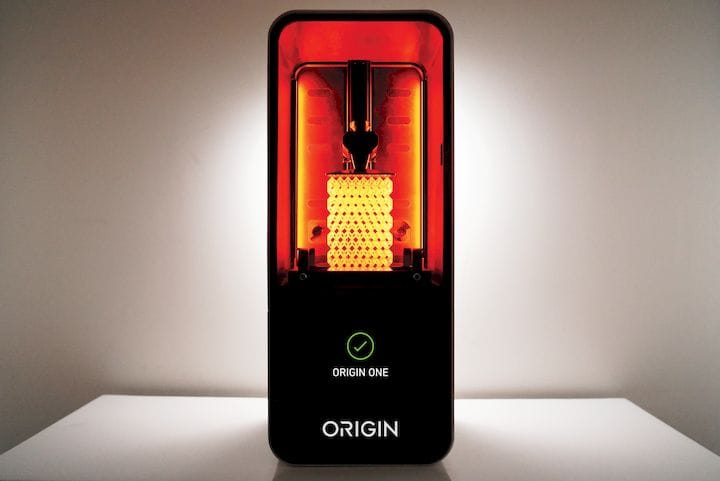![The Origin One manufacturing 3D printer [Source: Origin]](https://fabbaloo.com/wp-content/uploads/2020/05/image-asset_img_5eb09752d0665.jpg)
Origin has finally revealed their mysterious 3D printer: The Origin One.
The company has been extremely secretive. We did not even know they existed until only a few months ago, when Origin suddenly appeared on the scene. However, while their claims were substantial, there was little evidence or information provided beyond some early images and process schematics.
Whatever it is they are doing, it has attracted a significant amount of investment thus far.
Now we know a lot more, as they have announced their first device, the Origin One.
It is a photopolymer device that has a modest but tall build volume of 192 x 108 x 350 mm. At first glance you might think the Origin One is simply yet another of what seems to be dozens of similarly-appearing desktop resin 3D printers. But the secret of Origin’s process lies invisibly inside the device.
They use an approach called “P3”, which stands for “programmable photopolymerization”. We still don’t know much about it, but it seems to be some type of closed loop process that enhances the standard photopolymer process.
Normally, a photopolymer 3D printer must be precisely tuned: the laser (or other illumination source) must be set to provide lighting per pixel at a very precise strength and time. The temperature of the build chamber and resin must be within a very tight window, and other parameters.
These are most often discovered by trial and error by a resin 3D printer manufacturer, who then records them as a “profile” to accompany the sales of their proprietary resins at great profit. The profiles ensure printing success, but there’s a cost to the user to obtain that benefit.
The P3 process, on the other hand, seems to propose an open materials approach, in which an arbitrary material can be used, and the machine’s feedback mechanisms can gradually determine the best parameters for printing. Or at least that’s we can guess based on what we’ve seen so far.
They’ve also provided for a post-processing step to simplify workflows. They explain:
“Origin One uses P3 to precisely control light, heat, and forces among other variables to produce parts with exceptional accuracy and consistency. A responsive print process monitors polymerization data and automatically optimizes process conditions for the best possible results. The optimized build volume (192x108x350mm), compact footprint, and fast post-processing enable manufacturers to maximize production capacity per sq ft. One operator can manage a large fleet to produce thousands of parts a day without the need for external automation.”
And:
“Unlike existing industrial additive equipment from companies like Carbon and 3D Systems, Origin provides modular, scalable hardware and software supplemented by an open materials network which will lean on leading chemical experts to expand the choice of materials available to manufacturers. By decoupling material development and printing, Origin delivers a far broader choice-set of materials specifications (including custom materials), at costs sufficiently lower to enable mass production. Today Origin’s customers can choose from resilient elastomers, silicones, high heat, and high impact materials ready for end use applications.”
They seem to be able to produce highly accurate prints, as seen in these images:
![Sample high-resolution test print from the Origin One [Source: Origin]](https://fabbaloo.com/wp-content/uploads/2020/05/Origin-ChallengeBack-79mm-x-44mm_img_5eb0975323603.jpg)
![Sample high-resolution test print showing dimensions from the Origin One [Source: Origin]](https://fabbaloo.com/wp-content/uploads/2020/05/Origin-Skate-Park-Dimensions_img_5eb0975377e0d.jpg)
This sounds very intriguing, but we have many questions that we will pose to Origin when we see them at RAPID + TCT.
Via Origin











A research thesis details the incredibly complex world of volumetric 3D printing. We review the highlights.